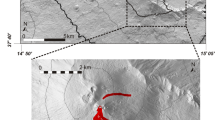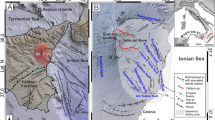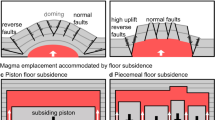Abstract
VOLCANOES erupt when the pressure in a magma chamber several kilometres below the edifice overcomes the strength of the intervening rock. Seismic activity may accompany and precede eruptions, allowing (in favourable circumstances) the location and movement of magma to be traced. Ground deformation near volcanoes can provide more direct evidence for magma movement, but continuous monitoring is necessary to ensure that all the essential aspects of an eruption are recorded. Here we report dilatational strain data collected continuously during the January 1991 eruption of Hekla volcano by five borehole strainmeters located 15–45 km from the volcano. The data record the upward propagation of magma, as well as the deflation of a deep reservoir. In only 30 minutes the magma forced open a conduit to the surface from a depth of ∼4km. Although other volcanoes might behave differently, our results suggest the possibility of using continuous deformation measurements to monitor conduit formation at other sites, perhaps providing short-term warnings of impending eruptions.
This is a preview of subscription content, access via your institution
Access options
Subscribe to this journal
Receive 51 print issues and online access
$199.00 per year
only $3.90 per issue
Buy this article
- Purchase on Springer Link
- Instant access to full article PDF
Prices may be subject to local taxes which are calculated during checkout
Similar content being viewed by others
References
Sacks, I. S., Suyehiro, S., Evertson, D. W. & Yamagishi, Y. Pap. Met. Geophys. 22, 195–208 (1971).
Kjartansson, E. & Gronvold, K. Nature 310, 139–141 (1983).
Sigmundsson, F., Einarsson, P. & Bilham, R. Geophys. Res. Lett. 19, 1483–1486 (1992).
Tilling, R. I. & Dvorak, J. J. Nature 363, 125–133 (1993).
Shimada, S. et al. Nature 343, 631–633 (1990).
Okada, Y. & Yamamoto, E. J. Phys. Earth 39, 177–195 (1991).
Gudmundsson, A. et al. Bull. volcan. 54, 238–246 (1992).
Stefansson, R. et al. Bull. seism. Soc. Am. 83, 696–716 (1993).
Okada, Y. Bull. seism. Soc. Am. 75, 1135–1154 (1985).
Yang, X., Davis, P. M. & Dieterich, J. H. J. geophys. Res. 93, 4249–4257 (1988).
Gudmundsson, A. Tectonophys. 176, 257–275 (1990).
Sato, H. & Manghnani, M. H. Phys. Earth planet. Inter. 41, 18–33 (1985).
Palsson, S., Haraldsson, G. I. & Vigfusson, G. V. Report No. 0S-84048/V0D-18 B (National Energy Authority, Reykjavik, 1984).
Thorarinsson, S. & Sigvaldason, G. E. Bull. Volcan. 36, 269–288 (1973).
Gronvold, K., Larsen, G., Einarsson, P., Thorarinsson, S. & Saemundsson, K. Bull. Volcan. 46, 349–363 (1983).
Author information
Authors and Affiliations
Rights and permissions
About this article
Cite this article
Linde, A., Agustsson, K., Sacks, I. et al. Mechanism of the 1991 eruption of Hekla from continuous borehole strain monitoring. Nature 365, 737–740 (1993). https://doi.org/10.1038/365737a0
Received:
Accepted:
Issue Date:
DOI: https://doi.org/10.1038/365737a0
This article is cited by
-
Tidal Calibration of the Gladwin Tensor Strain Monitor (GTSM) Array in Taiwan
Pure and Applied Geophysics (2024)
-
The centenary of IAVCEI 1919–2019 and beyond: The people, places, and things of volcano geodesy
Bulletin of Volcanology (2022)
-
Episodic transport of discrete magma batches beneath Aso volcano
Nature Communications (2021)
-
Transfer Functions of Borehole Dilatometer Responses to Atmospheric Loading from Low- to High-Frequency Bands: A Systematic Study in Mainland China
Pure and Applied Geophysics (2021)
-
Geophysical precursors of the July-August 2019 paroxysmal eruptive phase and their implications for Stromboli volcano (Italy) monitoring
Scientific Reports (2020)
Comments
By submitting a comment you agree to abide by our Terms and Community Guidelines. If you find something abusive or that does not comply with our terms or guidelines please flag it as inappropriate.



